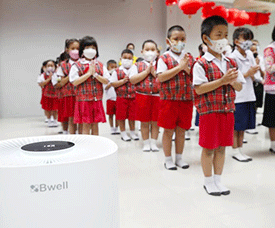Over 100 deaths a day: UN warns of air pollution’s toll on young children in East Asia, Pacific
SINGAPORE (The Straits Times/ANN) -- More than 100 children under the age of five die each day in East Asia and the Pacific from air pollution-related causes, said Unicef on Feb 6, in a call for urgent action to cut deadly emissions, toughen air quality standards and improve health systems.
 |
| More than 500 million children live in East Asian and Pacific countries with unhealthy levels of pollution. -Photo EPA-EFE |
The toll translates to nearly 40,000 deaths annually among children under five in the two regions.
The United Nations Children’s Fund said more than 500 million children live in East Asian and Pacific countries that have unhealthy levels of pollution, with exposure to toxic air outside and inside the home. That exposure can start even before they are born, leading to lifelong health complications.
Household air pollution is especially dangerous. Fuels used for cooking and heating, such as wood and dried dung, are linked to more than half of all air pollution-related deaths in children under five.
But steps can be taken to combat the crisis, Unicef said in its report, Growing Up In The Haze, which is an advocacy brief to nudge governments to act.
“Air pollution is a silent threat, but everyone has a role in making its impact visible and taking action,” said Mr Samuel Treglown, Unicef’s regional climate and sustainable environment consultant.
Thailand has been facing hazardous air pollution, exacerbated by farmers burning crops and air pollution peaking in many parts of the region during the dry season until April.
“With air pollution levels in East Asia and the Pacific reaching dangerously high levels, this is a critical moment to sound the alarm,” Mr Treglown told The Straits Times.
The report focuses on 27 developing nations including China, Indonesia and the Philippines, and as far as Kiribati and Tuvalu in the Pacific. It analyses 2021 data from the Institute for Health Metrics and Evaluation, a public body based at the University of Washington in Seattle.
“Analysing the data, the scale of the crisis became undeniable: Nearly one in four deaths of children under five in the region is linked to air pollution, making it the second-leading risk factor for child mortality after malnutrition (for children under five),” Mr Treglown said.
Globally, nearly 2,000 children die every day from health problems linked to air pollution, which is now the second-biggest risk factor for early death worldwide, according to a 2024 joint report by Unicef and the US-based non-profit Health Effects Institute.
Exposure to air pollution contributed to the deaths of 8.1 million people of all ages – around 12 percent of all fatalities – in 2021, according to the report.
China has the largest number of children at risk in East Asia and the Pacific, with nearly 300 million, Unicef said in its latest assessment.
To reduce the threat from household air pollution in China, Unicef has introduced chimney ventilation, fans and air purifiers to cut exposure to pollutants. In Mongolia, traditional tents, or gers, are fitted with electric heaters, insulation and ventilation systems to replace coal stoves.
Apart from households, air pollution has many other sources, such as factories and power plants, emissions from transport as well as forest fires and agricultural burning. These emissions release toxic compounds such as carbon monoxide, nitrous dioxide and ozone.
Most dangerous are tiny airborne particles called PM2.5 that get deep inside the lungs and into the bloodstream.
PM2.5 particles measure less than 2.5 micrometres in diameter, and prolonged exposure can cause severe illness and death.
More than 325 million children live in countries where the average annual PM2.5 level exceeded World Health Organisation guideline levels by over five times, Unicef said.
Prolonged exposure to air pollution in children can cause a range of respiratory illnesses, delayed brain development, impaired immune response, diabetes and cancer. This leads to high health costs and, ultimately, lost productivity for societies.
“When children are sick, parents are forced to miss work to care for them or take them to the doctor, reducing household income and productivity,” Mr Treglown said.
But there are some positive signs of change, with daily deaths declining.
He said child deaths linked to air pollution in East Asia and the Pacific dropped by 78 percent between 2000 and 2021. “This progress reflects improvements in air quality and child health interventions across the region over the last few decades,” he noted.
However, deaths in children under five linked to outdoor air pollution have declined at a slower rate of 54 percent, highlighting the need to accelerate efforts to tackle air pollution, particularly from outdoor sources such as traffic, industry and waste burning.
In addition, deaths linked to outdoor pollution have risen to about 40 percent, Unicef said.
Governments must strengthen environmental policies, transition to clean energy, and enforce air quality standards, according to Mr Treglown. Businesses should also adopt cleaner technologies and practices, while the health sector must improve diagnosis and treatment.
Awareness is also key, and parents and educators can teach young people about the risks of air pollution, steps they can take to reduce the threat, and how to advocate for change.
Climate change remains a major threat, Mr Treglown noted.
“Air pollution and climate change are deeply connected – the same sources polluting the air children breathe are also fuelling the climate crisis,” he said.
“Reducing greenhouse emissions isn’t just about the planet – it’s about protecting children’s health now.”
(Latest Update February 7, 2025)
|